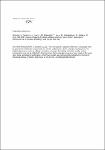Cryo FIB-SEM: Volume imaging of cellular ultrastructure in native frozen specimens
Schertel, Andreas
Snaidero, Nicolas
Han, Hong-Mei
Ruhwedel, Torben
Laue, Michael
Grabenbauer, Markus
Möbius, Wiebke
Volume microscopy at high resolution is increasingly required to better understand cellular functions in the context of three-dimensional assemblies. Focused ion beam (FIB) milling for serial block face imaging in the scanning electron microscope (SEM) is an efficient and fast method to generate such volume data for 3D analysis. Here, we apply this technique at cryo-conditions to image fully hydrated frozen specimen of mouse optic nerves and Bacillus subtilis spores obtained by high-pressure freezing (HPF). We established imaging conditions to directly visualize the ultrastructure in the block face at −150 °C by using an in-lens secondary electron (SE) detector. By serial sectioning with a focused ion beam and block face imaging of the optic nerve we obtained a volume as large as X = 7.72 μm, Y = 5.79 μm and Z = 3.81 μm with a lateral pixel size of 7.5 nm and a slice thickness of 30 nm in Z. The intrinsic contrast of membranes was sufficient to distinguish structures like Golgi cisternae, vesicles, endoplasmic reticulum and cristae within mitochondria and allowed for a three-dimensional reconstruction of different types of mitochondria within an oligodendrocyte and an astrocytic process. Applying this technique to dormant B. subtilis spores we obtained volumes containing numerous spores and discovered a bright signal in the core, which cannot be related to any known structure so far. In summary, we describe the use of cryo FIB-SEM as a tool for direct and fast 3D cryo-imaging of large native frozen samples including tissues.
No license information

